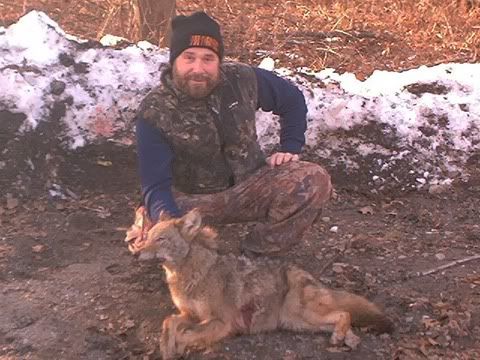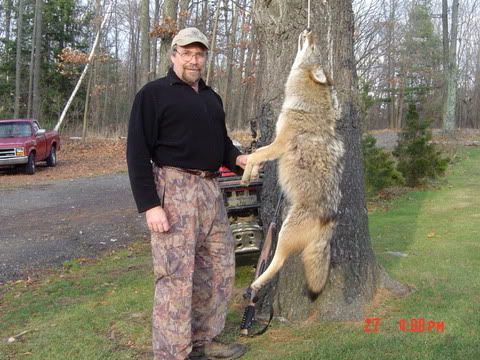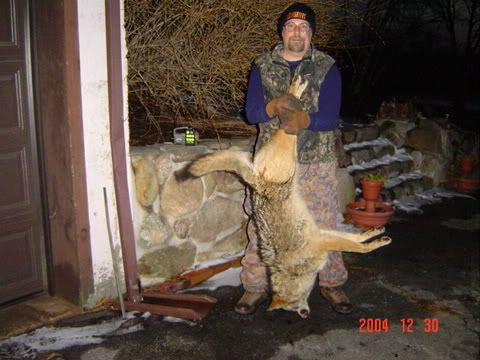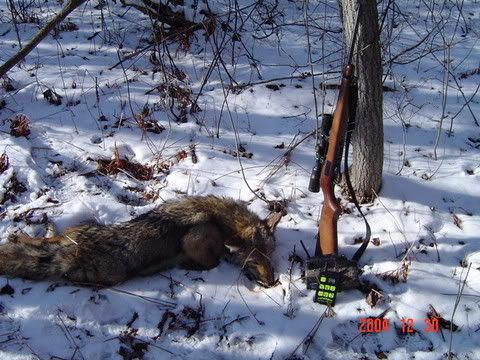GeorgiaJoe
New member
-When the .204 Ruger was first introduced the "headline" was the velocity of the 32gr V-Max @4200 fps. It got lots of attention and lots of people "jumped on the wagon" and bought one. I soon started seeing good reports as a varmint gun but bad reports on it as a coyote round. I had wanted to "get on the wagon" also but decided to do some research before making the investment. {In Georgia there are no PD's and non-game animals are the only critters you can shoot with the .204. It's not legal for deer (.22 cal. or larger), it's not legal for fur bearer like bob-cat and fox (rim fire or shotgun with #2 shot or smaller), so coyote and ground-hog are about it.}What I found I thought was interesting so I thought it was worth sharing.
-As most of you know the key is the energy at impact, not the muzzle velocity. The recommended energy for killing a coyote sized animal(In GA 35 - 40 lbs)humanely is between 550 and 600 ftlbs according to the ballistics calculator I am using. I'm seeing the 32gr V-Max running low on energy beyond 250 yds. The velocity is down to 2920 fps with 606 ftlbs at 225 yds. That along with the explosive nature of the V-Max bullet no wonder we're getting the bad reports. If we look at the "Balistic Coefficient" it is below .2. That's why it looses steam so fast.
-Now let's look at a bullet with a great "B.C." and slightly less explosive; the 39gr Sierra Blitz King. The muzzle velocity is around 3850 (via Silverfox), nothing to bragg about. But look how far it holds its energy. Remember the 225yd #'s above. At 225yds the 39BK has 788ftlbs at 3017 fps and the energy stays above the 550 mark out to 375 yds where it is 558 ftlbs at 2539 fps. VERY impressive!(At least to me it is.) That's right on the heels of the 22-250 load that I shot. It didn't loose the flat trajectory of the 32gr either. The high point is 1.8" @ 150yds and @ 300yds it's -2.3" (@ the 375yd mark it's -8.0"). I hope some of you enjoy reading this as much as I enjoyed finding it. The #'s came from http://www.biggameinfo.com/BalCalc.aspx .
GAJoe
-As most of you know the key is the energy at impact, not the muzzle velocity. The recommended energy for killing a coyote sized animal(In GA 35 - 40 lbs)humanely is between 550 and 600 ftlbs according to the ballistics calculator I am using. I'm seeing the 32gr V-Max running low on energy beyond 250 yds. The velocity is down to 2920 fps with 606 ftlbs at 225 yds. That along with the explosive nature of the V-Max bullet no wonder we're getting the bad reports. If we look at the "Balistic Coefficient" it is below .2. That's why it looses steam so fast.
-Now let's look at a bullet with a great "B.C." and slightly less explosive; the 39gr Sierra Blitz King. The muzzle velocity is around 3850 (via Silverfox), nothing to bragg about. But look how far it holds its energy. Remember the 225yd #'s above. At 225yds the 39BK has 788ftlbs at 3017 fps and the energy stays above the 550 mark out to 375 yds where it is 558 ftlbs at 2539 fps. VERY impressive!(At least to me it is.) That's right on the heels of the 22-250 load that I shot. It didn't loose the flat trajectory of the 32gr either. The high point is 1.8" @ 150yds and @ 300yds it's -2.3" (@ the 375yd mark it's -8.0"). I hope some of you enjoy reading this as much as I enjoyed finding it. The #'s came from http://www.biggameinfo.com/BalCalc.aspx .
GAJoe
Last edited:






